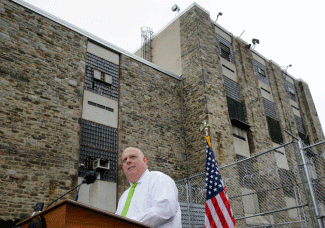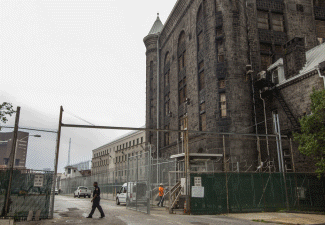By RICHARD A. OPPEL Jr.
JULY 30, 2015
NOTICE: THIS WORK MAY BE PROTECTED BY COPYRIGHT
YOU ARE REQUIRED TO READ THE COPYRIGHT NOTICE AT THIS LINK BEFORE YOU READ THE FOLLOWING WORK, THAT IS AVAILABLE SOLELY FOR PRIVATE STUDY, SCHOLARSHIP OR RESEARCH PURSUANT TO 17 U.S.C. SECTION 107 AND 108. IN THE EVENT THAT THE LIBRARY DETERMINES THAT UNLAWFUL COPYING OF THIS WORK HAS OCCURRED, THE LIBRARY HAS THE RIGHT TO BLOCK THE I.P. ADDRESS AT WHICH THE UNLAWFUL COPYING APPEARED TO HAVE OCCURRED. THANK YOU FOR RESPECTING THE RIGHTS OF COPYRIGHT OWNERS.

Gov. Larry Hogan at the Baltimore detention center on Thursday. The jail grabbed headlines in 2013 after a federal indictment exposed an almost dystopian environment rife with corruption. Credit Patrick Semansky/Associated Press
The man who until recently ran the huge, fortresslike city jail in Baltimore impregnated four corrections officers, bought fancy cars and demanded unchallenged loyalty, investigators would later say.
“This is my jail,” he was heard boasting on a wiretap.
That boss — Tavon White — was not the warden. He was an inmate himself, the head of a gang that actually ran the jail, according to federal prosecutors who brought racketeering and drug charges against him and 43 other inmates and guards.
Now, the state-run jail faces its own reckoning. On Thursday, the governor of Maryland, Larry Hogan, ordered the facility, known as the Baltimore City Detention Center, shuttered immediately, and the remaining 750 male prisoners moved to other facilities.
The jail, which dates to the Civil War, will be torn down, its nearly 800 employees transferred.
The governor cited the jail’s extraordinary history of corruption, as well as “horrendous” living conditions.
Descriptions of the detention center contained in federal indictments read like cable television scripts about a dystopian prison, where inmates intimidated and co-opted guards, slept with some and carried out a profitable drug trade that used smuggled cellphones to communicate and transfer money inside and out.

Outside the Baltimore City Detention Center on Wednesday. Credit Nate Pesce for The New York Times
Or, as Mr. Hogan said on Thursday, “Inmates were literally running this prison.”
“Making matters even worse, a number of employees either stood by, or in many cases enabled these criminals and the vast corruption that quickly followed,” he said.
“Maryland taxpayers were unwittingly underwriting a vast criminal enterprise run by gang members and corrupt public servants.”
It is a characterization that the F.B.I. and prosecutors publicly made in 2013, saying the jail was being run by members of the Black Guerrilla Family, the gang that Mr. White commanded.
Gang members had cemented control not just from payoffs or profit-sharing, but also by having sex with many of the female guards, manipulating the very people who were supposed to be watching over them.
Corrupt corrections officers, an F.B.I. affidavit said, “give their allegiance and loyalty to these inmates in an effort to make money and/or further their sexual relationships.”
By one inmate’s estimate cited in the affidavit, about two-thirds of the guards smuggled contraband or were having sex with inmates.
Gang documents recovered by officials at a Maryland prison even described how Black Guerrilla Family recruits were instructed to “target a specific stereotype” of corrections officer who could be easily manipulated: “Women with low self-esteem, insecurities and certain physical attributes.”
Mr. White, 37, pleaded guilty to federal racketeering and conspiracy charges and was sentenced in February to 12 years in prison, to be served concurrently with a 20-year prison sentence imposed after he pleaded guilty in state court to attempted murder.
All told, the United States attorney in Maryland said, 40 of 44 defendants have been convicted or pleaded guilty.
Yet the prosecutions of the gang members and their guards did not ameliorate the inhumane conditions at the jail, which, as Mr. Hogan noted Thursday, affected inmates who were largely awaiting trial.
“Still, they are forced to live in substandard, frankly appalling circumstances,” he said.
Just two months ago, the American Civil Liberties Union went to federal court to demand improvements, calling the detention center “a dank and dangerous place, where detainees are confined in dirty cells infested with vermin.”
The group said that parts of the jail were without working sinks or toilets for days at a time, while showers “were full of drain flies, black mold and filth.”
The A.C.L.U.’s national prison project director, David Fathi, said Thursday that his group was relieved that the detention center would be closed, saying it should have been condemned decades ago.
But he also called on the state to improve conditions in other jail facilities that he said have “dangerous physical conditions and shockingly deficient medical and mental health care.”
